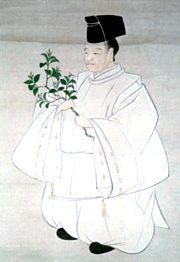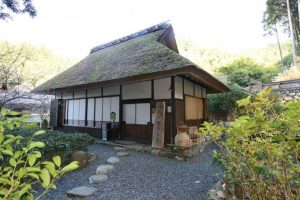Although sencha is one of the most famous Japanese teas, it wasn’t invented until the 18th century.
It’s hard to imagine now, but loose leaf tea in Japan was of very low quality back then.
Japanese tea before sencha was invented
At the second half of the 16th century, the shading method of cultivation (覆い下栽培) for tencha had been developed in Uji.
This made possible a matcha with higher sweetness and lower bitterness. However, matcha was only available to the upper classes of Japan’s society.
Common people drank tea that would seem very crude by today’s standard. A bancha of our time would be a great tea in comparison.
There wasn’t much selection when harvesting tea leaves, and the result would often be a tea which wasn’t even green, but brown.
Sometimes the tea leaves were steamed, other times they would be boiled, or even pan fired. This last method was used for making kamairicha, as the Japanese learned from China.
In another process the leaves would be rolled on a woven mat, or not rolled at all, and often left to dry under the sun. There wasn’t much to it.
To make matters worse, only some tea masters in Uji where allowed by the government to use the shading method for tea cultivation. That meant that most of the people had no access to high quality tea.
Nagatani Soen wanted to change that.
The story of Nagatani Soen

Nagatani Soen (永谷宗円) was born in 1681 in Yuyadani (湯屋谷村) village. In the present, it is Ujitawara (宇治田原町) town, Kyoto prefecture.
He was a tea farmer, and knew much about tea because he lived right next to Uji.
He wasn’t allowed to shade his tea plants, which led him to an interesting idea. What if he could make a better tea than what was available, but without the shading method?
He then decided to combine the different techniques available in his time.
Tencha was made by steaming tea leaves, and then drying in a furnace. On the other hand, in the kamairi method the tea leaves started to dry right away. Finally, the method of rolling tea leaves on the woven mat suggested that rolling was also beneficial.
What he eventually came up with was a real breakthrough. The rolling and drying would be done at the same time.
He placed a large sheet of paper on top of the furnace, and experimented with different rolling methods. That way the tea leaves would dry more evenly, and the result wouldn’t be as poor as when drying under the sun.
His last finding was that using young leaves improved the quality. This sounds obvious now, but at that time it wasn’t so apparent.
In 1738 Soen had successfully developed sencha. It took him 15 years. He was 58 years old at that time.
It did take a lot of work to make sencha, but the result was worth it.
The tea leaves were green, and had a fresh smell. Almost like the original unplucked leaf itsef.
When brewed, the liquour was a clear yellow, and in the mouth there was a harmony between sweetness, astringency and bitterness.
The needle shape of the tea was also beautiful, and the best thing was that it was possible for anyone to get this result.
This process was named aosei sencha seihou (青製煎茶製法), in which the first character refers to the green color of the tea leaves.
How sencha became famous
Nagatani Soen knew that he wouldn’t sell much of his tea in Kyoto because the locals were too conservative.
He had a better chance in Edo, the cultural center at the time and what is now known as Tokyo.
After the long trip, he quickly realized that his new tea would be very difficult to sell. It was too different to the teas that everyone was used to.
But the last place he visited brought his hopes back. It was the tea shop Yamamotoya (茶商山本屋), and the owner Yamamoto Kahei (山本嘉兵衛) was impressed with the tea’s flavor.
He bought the tea from Nagatani Soen, and made him promise to bring more the following year. He gave the tea a name: tenka ichi (天下一), which literally means “first under the heavens”. In other words, the best tea in Japan.
Mr. Yamamoto made the tea very popular and hence became very wealthy. As a token of gratitude, the company sent a sum of money every year to the Nagatani family until 1874. Note that Nagatani Soen died in 1778.
Sencha was one of the reasons why the Yamamotoyama company became so big and it’s still in business today.
The great achievement of Nagatani Soen
Soen isn’t praised mainly for his perseverance, although working for 15 years on a project is nothing to laugh at. Certainly most of us would have thrown in the towel in less that one third of that time.
His greatest achievement was that instead of keeping the process to himself for personal gain, he taught it to everyone that was willing to learn. That was how sencha ultimately spread throughout Japan. His process is the pillar of Japanese tea processing.
If you want to see the hand rolling process in action, take a look at my post about the temomi process.
Of course, the kamairi method and the ancient bancha teas still remain, but they are a minority.

In the present, Soen’s house is preserved as a sort of museum in Ujitawara town: Nagatani Soen Seika (永谷宗円生家).
Many of his belongings and even what’s left of his furnace are still there.
Close by, a temple was named in his memory: Chasoumyou jinja (茶宗明神社).
Sources:





November 4, 2016
This was actually REALLY useful information for me. Mainly for something fictional that I have on the horizon.
As for Yamamotoyama. I knew they were around a LONG time, but I had no idea they were instrumental in the spread of sencha techniques.
Fun fact: They own Stash Tea.
November 5, 2016
Hi Geoff, thanks for commenting.
I can’t wait to read your tea fiction!
Here’s another fact about Yamamotoyama: they were also instrumental in the creation of gyokuro.